Mayan Backroads in a Wheelchair
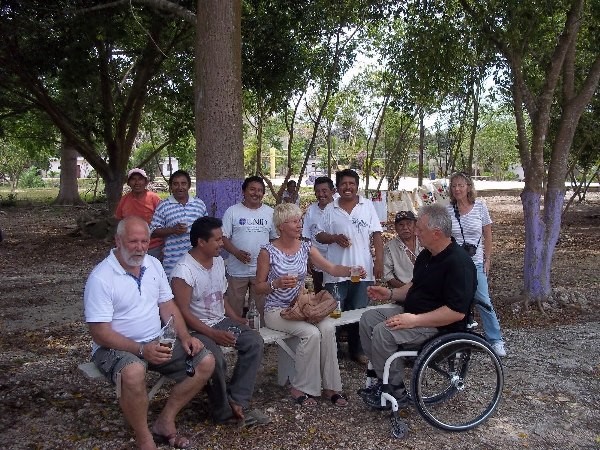
Quenching thirsty throats after a tour
[April/May 2014] Four travelers came to visit the meanwhile touristy Riviera Maya and they were so much fun! Being 2 couples, they had been traveling around the globe together for the past 20 years or so. We started co-creating a few tours back in August 2013, and April 2014 was when the rubber hit the road.
It was their first time traveling to the Yucatan peninsula and we decided to visit Chichen Itza, because it’s an astonishing ancient city and it’s one of the 7 Modern World Wonders. You don’t want to miss this kind of place. Most of my wheelchair-bound travelers rent an electric scooter for this tour, but Dieter, the wheelchair user of the group, managed the trails through the archaeological site in his sporty wheelchair with ease. He even advanced to the sacred cenote a slightly remote area where archaeologists, besides pottery and adult bones, found lots of children’s bones – an indicator of offering of the “precious” and “pure” and “valuable” to the gods. Zig-zagging our way via the ramps to the restaurant of the Mayaland Hotel, we enjoyed a delicious lunch. Yucatecan dancers regularly perform the Jarana dance in the restaurant, balancing a plate with water-filled bottles on their head. This was something that my travelers hadn’t seen before. If you want to avoid the big crowds at the main entrance of the Chichen Itza archaeological site, I recommend using the small parking lot of the Mayaland Hotel. That small entrance has wheelchair accessible restrooms as well, but getting an INAH-guide (certified Museum guide) in German or less common languages can be iffy. Also, you need to eat or stay at the hotel Mayaland in order to use their parking lot. The view of the observatory across the hotel main entrance is spectacular. On this tour, I usually stop in the colonial town of Valladolid for a short stroll and to give my travelers the opportunity to buy quality hammocks, leather shoes or other authentic souvenirs at very reasonable prices. This time we were passing through on our way to Chichen Itza – yet the group got a good idea of what Valladolid is like.
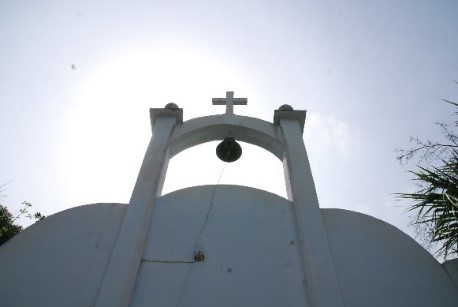
Tiny chapel in El Naranjal
The next tour was a debut for everyone. Project Mayan Encounter started working with the community of El Naranjal back in 2012. It started when I was researching the “Puerta Verde” – an eco-tourism project promoting the northern part of the peninsula. Unfortunately, the project had been abandoned, but a journalist from Kantunikil heard about me and directed the community leader of El Naranjal my way. It has become one of my most popular ecotour destinations since. El Naranjal is a neglected pearl in the lush jungle, with a recently inaugurated archaeological site and a cave cenote. I must say that Don Pedro, El Naranjal’s community leader, is one of the most dedicated persons I have worked with since launching Project Mayan Encounter in 2008. He had been in constant contact with me trying to draw visitors, and I had been invited to their community meetings to brainstorm and develop tours. Since our first talks, they have done an absolutely amazing job in hand-carving an access to the cave cenotes. A wooden stairway reaches all the way down to the water, where in 2012 we had to craw down on our butts! They have installed lightening that is run by a generator which they turn on only when visitors enter the cave. Another beautiful surprise was that a shaman purified each of us with incense before entering – they say that this is done to the villagers as well before they enter.
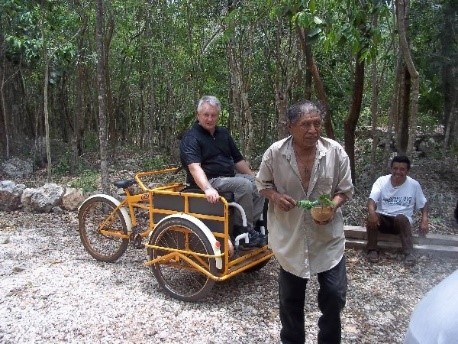
Shaman purifies us with copal incense
Even Dieter got his purification with the delicious-smelling Copal (a tree resin), even though he had to stay up while the rest of us entered the cave cenote. Dieter was lifted onto a cargo bike, while staying in his wheelchair, and then pedaled around. The wheels were secured with stones, and he held on to the rails of the bike’s crate. The Maya Rikshaw! We did a tour around the mystic archaeological site hidden in the lush jungle, and around the tiny village, before having home-cooked lunch in the house of one of the community members. When we entered the little church, one of the villagers was singing beautifully for us. Dieter glanced from outside, as well as when we visited the tiny museum, which showcases the pieces that the villagers hid to save them from the authorities who wanted to take them to the museum in Chetumal. Bravo, El Naranjal – great job! They are building a restaurant at the time of this writing, and I still receive my regular phone calls from Don Pedro, asking when I will bring visitors.
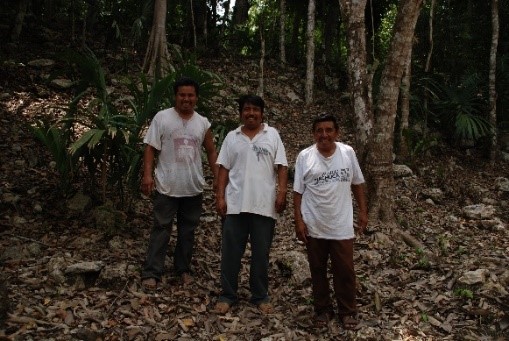
Don Pedro (r) with 2 other community members
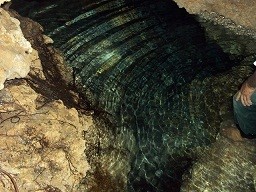
Cave cenote in El Naranjal
The third tour was unconventional as well: we visited my neighbor Chucho’s eco park Boca del Puma. Chucho can be seen as the pioneer of the Cenotes Trail and a lot of credit goes to him for developing this nature area. He presented a highly interesting talk about the history of this area in his mini-chicle-museum, that displays original artifacts of the chicle era. While chewing gum was cultivated and harvested in other parts on the Yucatan peninsula, the Ruta de los Cenotes was the hot spot for for export. The cicle era was flourishing until the gum was discovered by Thomas Adams, who later started reproducing chewing gum synthetically after joining with William Wrigley. In its place, tourism took off when Jacque Cousteau discovered Cozumel for diving, and Cancun was born. Today, a few countries start importing natural chicle from Mexico again: Germany, Japan and the UK as far as I know, because of its value as an organic tooth cleaner. In the future Chucho wants to demonstrate the cooking process of the chicle mass at Boca del Puma, involving the visitors actively, and using all the original artifacts that they saved from the old days.
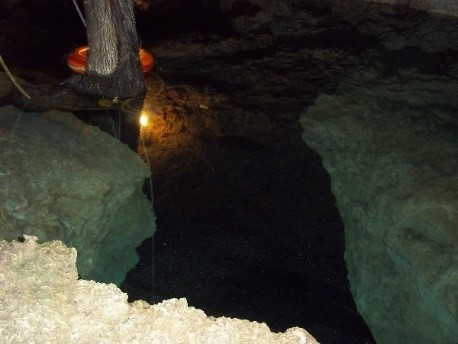
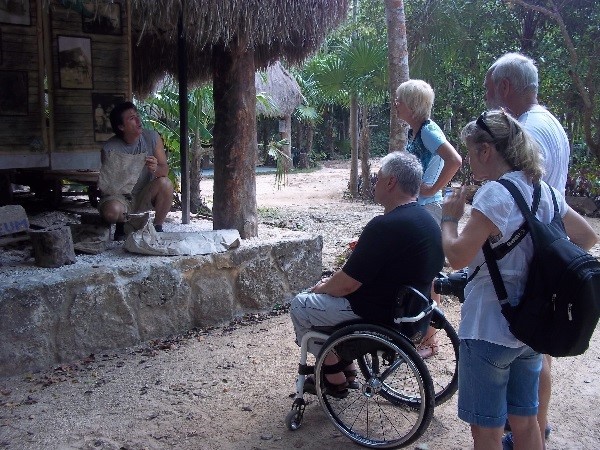
Boca del Puma has a cave cenote and an open one. The open one is modified with natural stones to keep mud from sliding in during raining season, so that the water stays clearer. There are two openings to a connecting canal that one can enter and get out at the other end. The cave cenote has a rather small entrance and it can be challenging for visitors because they have to float across a very shallow section to get into the big cave with a high ceiling. Chucho and his men prepared to help Dieter into the water with manpower, but in the end none of us felt like getting wet – except some of our feet. We enjoyed Chucho’s history talk and demo tremendously though, as well as the lush tropical jungle setting.
I’m always grateful for travelers with a sincere interest in learning about local culture, fauna and flora. And I enjoyed the company of my four fellow Germans, Dieter, his wife Carmen, and their friends Evi and Peter because of their playful and humorous approach to life. I believe that these are the kind of people who are drawn to specialized tours with Project Mayan Encounter, where a wheelchair is no handicap at all. On the contrary, I find that doors swing open all the time, and many hands come to help whenever we have a wheelchair-bound person in the group.
By the way, the Viva Maya Azteca in Playa del Carmen (Hotelzone Playacar), where my fellow Germans stayed, has a beach wheelchair that guests can use for free.
If you would like to know more about wheelchair-accessible tours and accommodation in the Riviera Maya, and best times to travel, please feel free and email me!

Leave A Comment